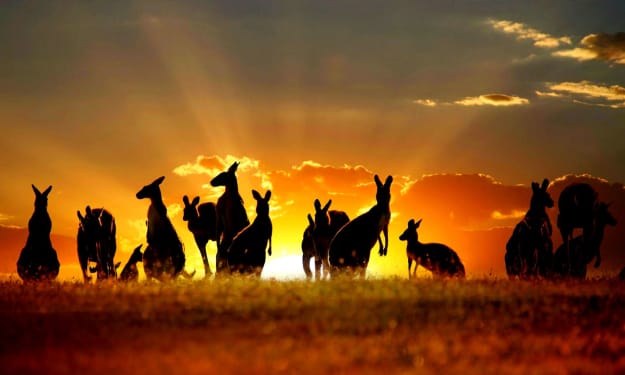Why dinosaurs are not all extinct
Once the dominant generation on earth

I believe that we are not unfamiliar with dinosaurs, after all, they were once the dominant generation on Earth, we usually think that dinosaurs are ancient creature that has long been extinct, and in modern times there are no more dinosaurs alive on Earth.
However, there is a view that in fact, dinosaurs are not all extinct, they are still living on Earth, and even everywhere around humans, why say so? The reason is: that all birds on modern Earth are direct descendants of dinosaurs. Let's see what this is all about.
When it comes to the origin of birds, we have to talk about the "ancestor birds", which were once considered to be the earliest birds on earth, and whose first fossil sample was found in 1861 in the Solenhofen limestone in southern Germany. The first fossil sample was found in 1861 in the Solenhofen Limestone in southern Germany, and it was found that the "ancestor bird" had some bird features (e.g., feathers, wings, forked bones, hind feet with opposite toes) as well as some dinosaur features (e.g., jaws with grooved teeth, dinosaur-like hind limbs, feet with three-toed claws, a biconcave spine, and a long bony tail).
It has been suggested that birds originated from dinosaurs and that the "ancestor birds" were a transitional species between birds and dinosaurs, but since there are very few fossil samples of the "ancestor birds" and their distribution area is very small, this theory has not been This was not universally accepted because of the small number of fossil samples and the small area of distribution. Over the next few years, as fossil samples increased, it became clear that birds and dinosaurs had many similar physiological traits.
For example, dinosaurs and birds have a variety of bones (such as the neck bone, pubic bone, carpal bone, keel, etc.) that have very similar characteristics, and even some dinosaur bones are hollow structures like those of birds.
For example, birds have a special way of breathing - "double breathing", there are many air sacs made of the membrane in their body cavity, using these air sacs, the lungs of birds can have two gas exchanges in each breathing activity, thus making the birds The respiratory efficiency of birds is greatly enhanced. And fossil evidence suggests that many carnivorous dinosaurs also had complex cavities that were very similar to the air sacs of birds.
During egg-laying, for example, female birds create a special calcium-rich layer of bone between the outer bones of their wings and hind limbs and the bone marrow, known as medullary bone, which helps them create eggshells during egg-laying.
Among all known animals on modern Earth, the medullary bone is unique to birds, and fossil evidence suggests that traces of the medullary bone are present in fossils of Tyrannosaurus and Allosaurus of the suborder Theropoda, as well as in fossils of Tendonosaurus of the suborder Lizardopoda, because these dinosaurs evolved separately at a very early stage. Since these dinosaurs evolved separately at a very early stage, it can be assumed that dinosaurs commonly produced this particular bone layer.
Nevertheless, the idea that "birds originated from dinosaurs" is not universally accepted, because there is still one very important piece of evidence missing between birds and dinosaurs - feathers.
Feathers are a distinctive feature that distinguishes birds from other vertebrates, and for many people, "the presence or absence of feathers" is the decisive evidence to determine whether an animal belongs to birds, as well as in the paleontological world.
As mentioned above, the fossils of the Archaeopteryx are quite limited, and it has even been pointed out that the so-called "feather marks" in the Archaeopteryx fossils are made of collagen fibers. However, because the fragile feathers were extremely difficult to preserve during the fossil formation process, the relevant research work was slow to progress.
In the mid-1990s, the paleontological community finally saw a major development: Chinese paleontologists opened a world-class treasure trove of paleontological groups - the Jehol Biota and the Yanliao Biota - in the northern Hebei and western Liaoning regions of China.
A large number of fossils of feathered dinosaurs and early birds have been found here, including species older than the "Ancestor" (such as the "Ancestor") and closer to modern birds than the "Ancestor". "These fossils include species that are older than the Ancestor birds (e.g., the Ancestral Chinese pinnipeds) and species that are closer to modern birds (e.g., the Ancestral Chinese pinnipeds and the Confucius birds), thus providing strong evidence for the origin of birds.
As the research progressed, "birds originated from dinosaurs" soon became the mainstream view in the paleontological community, and the evolutionary route of birds was finally confirmed from numerous fossil evidence, which can be simply described as follows: Lizardiformes → Lower Pleurosauriformes → Main Pleurosauriformes → Bird-necked Pleurosauriformes → General Order of Dinosaurs → Lizard Rump → Theropoda suborder → hand-robberosaurs → ornithischians → birds.
In the 2010s, scientists studied the genes of birds from the perspective of molecular biology, and then completely determined the "kinship" between birds and dinosaurs, and identified birds as the "only dinosaur group" on modern Earth. In other words, not all dinosaurs are extinct, and some of them are still living on Earth.
On modern Earth, birds can be found everywhere around humans, and some birds (such as chickens, ducks, and geese) have long been domesticated by humans and used as a source of meat and eggs. It is sad to say that after tens of millions of long years, the dinosaurs, as the dominant generation on earth, were put on the table by the new generation of dominants on earth.
About the Creator
Robert Jack
One of the secrets of emotional stability for adults is to keep the expectations of others to a minimum.






Comments
There are no comments for this story
Be the first to respond and start the conversation.